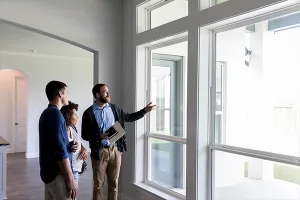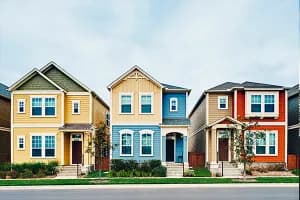With limited financing and consumers downsizing, small and slow is in when it comes to development today. Will it remain hot after the economy recovers?
Dan Camp purchased his first property in Starkville, Miss., in 1969, with a plan to build student housing. He had no idea he was beginning a 40-year process of transforming an entire neighborhood that once housed a cotton mill and housing for the mill’s workers.
“When I started, this was referred to as the Cotton Slum,” says the manager of Cotton District, a design, contracting and development company in Starkville. “It was a little section left out of the urban renewal area, and people thought I was stupid because it was so deplorable. The lots had collapsed tenant housing on them.”
But Camp says he happened on “one of those funny chances of being at the right place at the right time.” The then-28-year-old teacher spent $5,000 for land. He talked his way into 100 percent financing on a $50,000 loan and built an eight-unit townhouse modeled after the classical architecture of Alexandria, Va., New Orleans and Vicksburg, Miss.
“I had those townhouses rented in 30 days for $115 a month, and I think my note was $560-$570 a month at 6.8 percent interest,” Camp recalls. “My father told me not to quit teaching until I had 16 units.”
Camp followed his father’s advice and continued to slowly build small-scale projects on the compact lots throughout the neighborhood. Today, the unique and highly desirable 10-acre area is called the Cotton District. Its eight square blocks are crowded with about 100 of Camp’s single-family homes, duplexes and four-plexes totaling about 250 rental units.
Camp also had no idea he’d be on the forefront of a movement championing small-scale and slower-paced development. He just never wanted to be burdened with too much debt. “We’ve been doing small, incremental development because you don’t subject yourself to a large investment,” he says.
Yet Camp is among a growing group of developers and architects eschewing large-scale projects that create oversized homes in car-bound communities, leaving residents isolated from their neighbors. Another is Ross Chapin, whose “pocket neighborhoods” include cozy, typically less-than-1,000-square-foot homes clustered in groups of six to eight around a shared garden. Then there’s Bruce Tolar, whose Mississippi cottage communities are modeled after the Katrina Cottages, which sprung up to be less institutionalized housing that’s better apt to foster community-building than Federal Emergency Management Agency trailers.
“As we look at nearly 80 million baby boomers,” says Chapin, AIA, principal at Ross Chapin Architects in Langley, Wash., “I believe people are looking for smaller, high-quality, lower-maintenance homes in a setting in which they can easily know their neighbors.”
The origins of low-key development
It’s not that small-scale and slower-paced development has never taken place before in the United States. In the decades before American developers began to quickly mass produce large-scale residential developments, small and slow was the norm.
Les McCormick, AIA, owner of Atelier359 Studio for Architecture in Ashville, N.C., and Santa Rosa Beach, Fla., says the Lexington, Ky., planned development he grew up in, Ashland Park, was an early version of today’s small-scale, slow-growth development. “Development was planned and started prior to the first World War but not completed until the late 1950s,” he recalls. “The owners of a very large farm decided to divest themselves of their farming operation over time. "The Olmstead brothers did the design for the subdivision development, laying out the road only in notion and planting the streetscape while the family kept farming. After the vegetation grew for about 10 years, development began.”
Ashland Park’s residents and mix of housing were also different from most large developments today. “Some houses were single-family, some were duplexes, some were four-plexes and all were scattered into the development,” says McCormick. “They were for a variety of people, some single, some married with families and some retired couples. It wasn’t a monoculture. Houses faced parks, and there was a shopping district about a five-minute walk from most houses. It was designed and built as a middlenclass, mixed-dwelling neighborhood, and today it’s one of the most desirable in the city. "at was more common then. The nature of housing growth was slower than today because money was difficult to come by and people didn’t have the financing options we’ve had recently.”
Slow and Steady Wins the Race
Fast-forward to today, and financing is again scarce, especially for monster homes and large-scale developments. That, combined with the changing tastes of baby boomers and younger Americans, has re-energized the demand for small-scale and slower-paced development. Whether it’s a permanent shift is open for debate.
“Is this a trend out of necessity or something that’s emerging as a development business model?” asks Mark Stapp, a real estate professor at the W. P. Carey School of Business at Arizona State University in Tempe. “The answer is they’re correlated because developers can’t get any bloody funding. But here’s the benefit. You still have demand, and to respond to it, projects have become smaller, much more focused on local nuances, and more contextually responsive to their surroundings.”
R. John Anderson, principal at Anderson|Kim Architecture + Urban Design in Chico, Calif., says it remains to be seen whether smaller and slower is here to stay. “There’s an opportunity because of a gap in the market,” he says. “The current real estate system is set up with the expectation that a generation equally as large as the current one is going to move into today’s houses. But those folks just aren’t around. Members of Generation Y are delaying household formation and home purchases and want the same things baby boomers want now that they’re downsizing. At the time of the great senior selloff, Gen Y is looking to downsize and get closer to services. That will put further pressure on the big house.”
Anderson also points to the increase in single-person households. “In Chico, for example, which has about 100,000 people, about 52 percent of households have one person, and 70 percent have no children,” he explains. “The opportunity is: Can we deliver to an unmet need in the marketplace? I think that’s going to be for a well-located and well-designed rental that’s in town both for younger households and empty nest baby boomers.”
Chapin is less equivocal. “Small-scale is a trend because for baby boomers, the idea that people would want a home three times larger than they use every day and that turns its back to the street is becoming less appealing,” he says. “Also, the new generation is looking at urban, walkable communities, and the idea of a community-oriented setting is making a lot of sense.”
In addition, slower-paced projects are appealing because they can be built into larger projects. “Slower-paced development fits well with incremental and infill projects,” says Chapin. “There’s still room for grand plans if implementation happens incrementally.”
Chapin offers the example of a project he’s working on in Carmel, Ind., near Indianapolis. “There’s an overall plan for about 150 houses in a neighborhood setting,” he explains. “The developer isn’t sure of the market, so he’s testing it by building eight houses surrounding gardens. There are no driveways off neighborhood streets, and access to each home will be by a lane or alley. The incremental nature allows him to move toward the larger development step by step, and it fits into a larger plan. So smaller-scale units can be part of a large development, but also infill within existing neighborhoods. That gives smaller developers an opportunity to do viable projects and allows cities to meet their goals, which are typically to increase density within the core urban areas and provide more housing types and price points. "This is meeting a number of different needs at the same time.”
Will Bigger and Faster Return?
But will developers go back to their bigger and faster mode of operation when financing becomes less scarce? “As the economy and we change, I can’t in all good conscience say it’ll never go back to that,” says Stapp. “But in the next five to seven years, the business model for new development will be smaller scale and highly focused on particular market segments and unique local assets.”
However, the economy has forced developers to reevaluate what were once-settled assumptions. “The real estate business has become more sophisticated in seeking opportunities,” says Stapp. “The silver lining is that it’s caused people to stop and think about what they’re doing. The dialogue of smart growth and issues around food supply and organic gardening are collectively going to push us toward these unique projects. You have to find differentiators to be successful, and monolithic projects aren’t going to be dominant.”
Chapin is convinced demand won’t change much once the economy rebounds. “We’re not going backward to the way it was,” he contends. “We’re moving forward to higher-quality, closer, more neighborly and walkable developments with homes that require less maintenance and are more energy efficient. We’re just trying to create options that work for people. It could be your elderly mother, who needs a nice, safe little cottage where there are people around who can pay attention if her shades aren’t lifted by 10 a.m. Or it could be your 20-something child who has an opportunity to get his base established while he launches himself in the world. "This is about small houses serving your own family.
Four-Plex! Four-Plex! Getcher Free Four-Plex Prototype!
R. John Anderson says the future of rental housing will be small-scale, well-designed and well-located four-plexes, and he’s got just the design to meet that need.
The principal at Anderson|Kim Architecture + Urban Design in Chico, Calif., has designed a 4,500-square-foot mixed-use four-plex that can be financed with 20 percent down with a standard Federal Housing Administration-insured mortgage. And he’s sharing his prototype with anybody who wants it.
“This type of product is for both younger households and empty nest baby boomers,” explains Anderson. “The idea of a live-work four-plex goes to the upper limit of what Fannie Mae or Freddie Mac’s single-family mortgage will allow. You’re building a primary residence, so you get the loan. But the FHA has a limitation that the building can have no more than 20 percent nonresidential space. So we started with this puzzle: Imagine you’re living in the building, your office space is there, too, and you’ve got three more units you’re renting out. How could we con- figure a basic, straight-ahead building that people want to build out? "This was a way to build into future rental demand in a way that doesn’t require you to commit to building 150 units.”
Anderson says the design is flexible and economical. “It’s what we in California’s Central Valley call ‘basic nice,’” he says. “There’s lots of light and ventilation because there’s a basic storefront on the ground floor and two sizes of windows upstairs. The floor plan is efficient, and because of the way the building is designed, the heating and air-conditioning can be pretty simple. In our area, you can build it for $90 per square foot, and that includes $12 per square foot of impact fees.”
One benefit of Anderson’s four-plex design is that it can fit into many residential zoning schemes, though in some strictly residential areas, it may require up zoning. “This is a nice transition piece that could go very easily in the transition from a predominately commercial area to one that’s predominantly residential,” he explains.
Anderson is happily passing his design onto colleagues who ask. “If our colleagues want to take this and run with it, it’s all to the good,” he says. “An architect in Florida has done a South Beach model. Another in New Orleans did elaborate, old-school versions. And a member of the planning staff of Redwood City, Calif., is looking at 50 x 100-foot lots that have no alley, and he’s used the four-plex prototype to come up with incremental redevelopment plans for those lots.”
Pocket Communities: It’s All About Connecting
Pocket neighborhoods were introduced in 1996 with the "Third Street Cottages in Langley, Wash. “I was working with our little town on an innovative housing code,” explains Ross Chapin, AIA, principal at RossChapinArchitects in Langley, Wash. “The key element was that it would allow for twice the housing density on residential lots if the houses were less than 1,000 square feet, oriented around a shared garden, and parking was screened from the street. "This was the first cottage-housing zoning we know of in the country.”
Chapin and developer Jim Soules tested that new zoning code by building the "Third Street Cottages, a cluster of eight cottages on four lots. “It sold out immediately, proving there was a strong local market,” says Chapin. “Within three months, it appeared in national media. We realized we’d struck a hidden niche market nobody was addressing.”
Pocket neighborhoods tie into the burgeoning concept of placemaking. “In a subdivision, houses may face the street, but the life of the house is facing the backyard,” explains Chapin. “In a pocket neighborhood, houses and porches face a shared garden, and that’s where people come and go. Pocket neighborhoods not only create a place for neighbors to gather, they also connect and contribute to the surrounding neighborhood.”
Chapin and Soules have developed six other pocket neighborhoods in the Puget Sound, Wash., area. Homes have ranged from 800 to 2,500 square feet. The smallest neighborhood comprises eight houses; the largest 25. Price points have ranged from $140,000 to $850,000. “I’ve also designed 35 site plans for developers across the country,” adds Chapin.
There are drawbacks to pocket communities. “We have to modify them for a cold climate,” explains Chapin. “My preference is that people walk from the parking garage through the commons to their front door so the coming and going is through a shared green. But where it’s cold and inclement, that may stop some buyers. In those cases, people will look out on the commons, but they’ll get to their cars through a lane on a rear alley. "That’s not as good because pocket neighborhoods are really designing around the social dimension of nearby neighbors, and there’s less coming and going.”
There can also be zoning challenges. “Zoning may require you to have a house on a street with a street address, but these houses may be off a garden rather than a street,” says Chapin. “Also, some zoning codes have a minimum size requirement for houses and lots, and there can be maximum densities. But a house or lot size doesn’t have anything to say about quality, and maximum densities have nothing to do with privacy. Privacy is less a matter of distance than design. With poor design, you get a house plopped on a lot with no regard to the house on the next lot. You may have a living room looking directly at a neighbor’s bedroom. With good design, houses are created within the context of other homes, and no windows face each other. It doesn’t matter how close homes are. It matters how they’re situated and designed.”
Pocket neighborhoods probably won’t work everywhere, admits Chapin. “They don’t try to be the answer for everyone and everywhere,” he says. “They’re not. They’re an alternative for people who want closer interaction with neighbors combined with enough privacy, and they work best in walkable communities.”
The Courts at Whitham: Small Units, Big Impact
The Courts at Whitham, a three-story, 24-unit wood-frame courtyard apartment building near the University of Arkansas in Fayetteville, isn’t on a big parcel of land — it’s a mere 110 x 115 feet — and doesn’t have big units. “But it’s sort of a big-impact project,” says its architect, Robert Sharp of Robert Sharp Architect Inc. in Fayetteville.
"The project started as a four-story podium building dug into a hill with a layer of underground parking and an elevator. Alas, the market tanked and financing fell through. “We went back to the drawing board and did a more modest plan,” says Sharp. “We decided we didn’t need underground parking. The developer had two existing parking blocks, and the city allowed us to use street parking to meet parking requirements. You also get a 15 percent reduction in parking requirements if you’re close to a transit spot and a credit for including a certain number of bike parking stalls.”
The outcome is a building with 525-square-foot, one bedroom units with a long deck outside each unit that creates a courtyard. Since the project’s completion in April 2011, it’s been fully leased and has commanded a 40 to 50 percent rental premium over comparable apartments. “The units are stacked and have almost identical footprints, and they follow all the rules of economical apartment construction,” says Sharp. “But they’re fairly small for one-bedroom apartments. Some prospective tenants — mostly men — said that was a deal-breaker.”
Sharp says the project has been eye-opening. “I’ve learned that you can get 38 to 40 units per acre with surface parking,” he explains. Another revelation has been that the central courtyard can be a valuable meeting place for residents. “Overall, the courtyard has been a positive feature,” he says. “There are plotted plants and tables and chairs, and residents gather there.”
Sharp thinks being forced into smaller-scale projects has been positive. “We went from a pretty overheated market that was in disarray after 2008,” he says. “It’s coming back, but there’s a lot more humility and caution. Deals are smaller, and there aren’t the margins for error that there used to be.”
That newfound humility and caution is resulting in better projects and cities. “We’ve had a sea change, and we’re not going back to business as usual in the next five-10 years,” says Sharp. “We’ll all be working with smaller increments. We may do a large number of individual deals, but we won’t do massive projects. I think that’s good. The best places on earth are fine-grain urban places that have been built up over centuries, and each project and building built on what came before. The economics driving people toward more sensible projects will be a net benefit to our cities and towns.”
Katrina Cottages Become Permanent Mississippi Housing
Bruce Tolar immersed himself in the small-scale development world after Hurricane Katrina displaced millions of Gulf Coast residents. From that chaos emerged the Katrina Cottage, a mini-home intended as post-disaster temporary housing that would be a better alternative to the Federal Emergency Management Agency (FEMA) trailers that sprouted like — and were just as desirable as — weeds.
“Katrina Cottages were designed to be about the same size as a FEMA trailer, sleep a similar number of people and have similar amenities, like indoor plumbing and a kitchen — but to be real property,” explains Tolar, an architect at Bruce B. Tolar PA in Ocean Springs, Miss. “They would also be able to be moved as many times as you needed. The Mississippi Emergency Management Agency built about 3,000 one- to three-bedroom cottages ranging from 300 to 1,200 square feet to replace existing FEMA trailers. In 2007, whoever had a FEMA trailer got a Mississippi Cottage.”
From that, Tolar saw an opportunity for affordable housing. He created the 14-home Cottage Square on two acres in Ocean Springs. “Cottage Square began as a way to build a neighborhood that showed the concepts we’d been talking about with planning and rebuilding after disasters,” says Tolar. “Some of the first Mississippi Cottages became available, and we moved eight of them on site, took them off their trailers and located them on permanent foundations. Those have been affordable rental housing for almost four years. Cottage Square was a model in the beginning, but it became a development as we added more cottages.”
Tolar has since completed additional cottage neighborhoods. “After using the cottages, the state had several thousand available for reuse,” he explains. “I worked with Mercy Housing and Human Development on a proposal to build small neighborhoods. Our sites have ranged from 6 to 80 units. But we’ve found that the size that’s best — that builds a better neighborhood — is 20 to 30 units on 2 to 2.5 acres.”
One such site is the Cottages at Oak Park, which neighbors Cottage Square and groups 30 one- to three bedroom cottages. A similar project is underway in Pass Christian, Miss. “They’re the latest models of what we call eco-cottages,” he says. “They meet the minimum standards for Leadership in Energy and Environmental Design Silver, and all are affordable rental housing. The Oak Park units rent from $600 a month for a one bedroom to $1,150 for a three-bedroom. We’ve been able to achieve all that for under $100 per square foot in development costs, not including site fees.”
Since Katrina, Tolar has thought smaller-scale neighborhoods were a better development model than continued subdivision of greenfields. “We were looking at it as a recovery solution for disasters — smaller housing in neighborhood settings,” he says. “With the downturn in the economy, the need for this solution became even more apparent. We found you could use better sustainability and energy efficiency to build smaller-square- footage, but better-square-footage housing. We’re finding the desire for the smaller footprint from people at retirement age and people coming into the workforce looking for something they can purchase or rent.”








